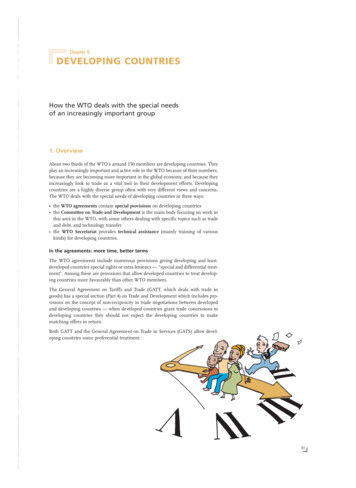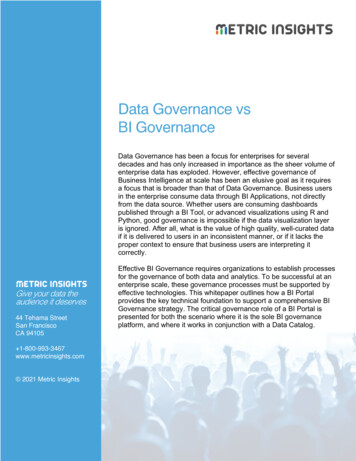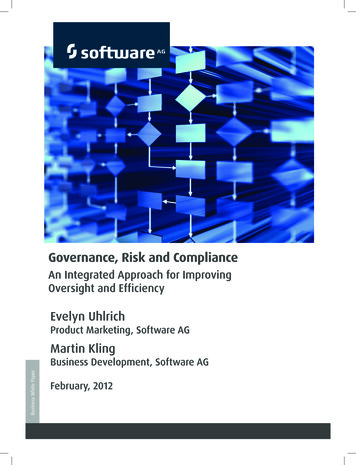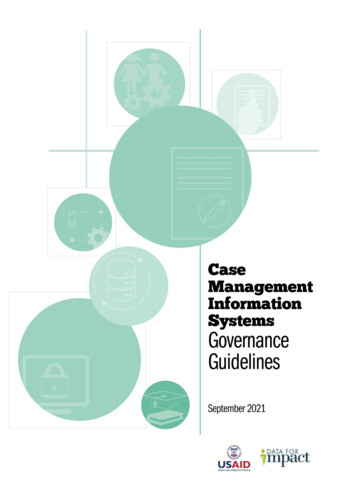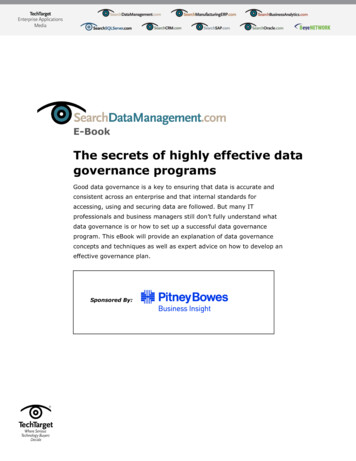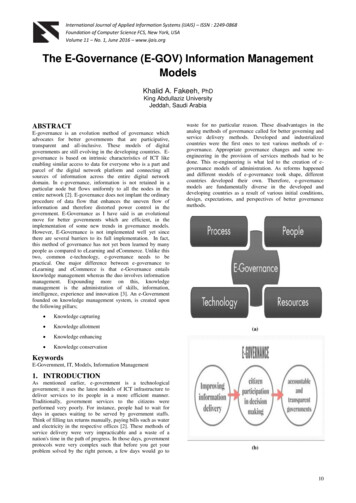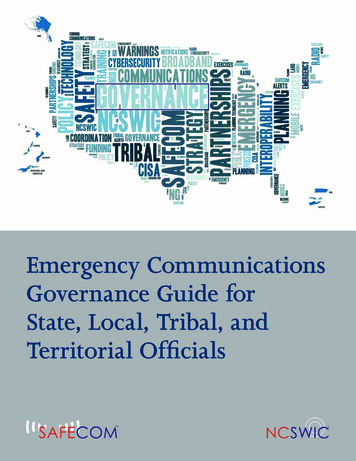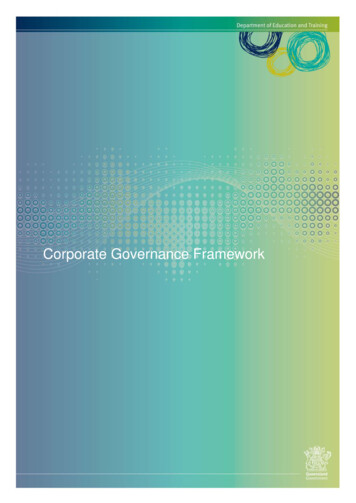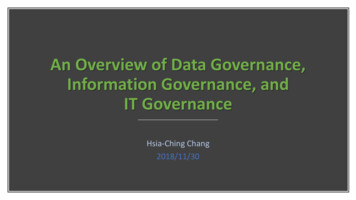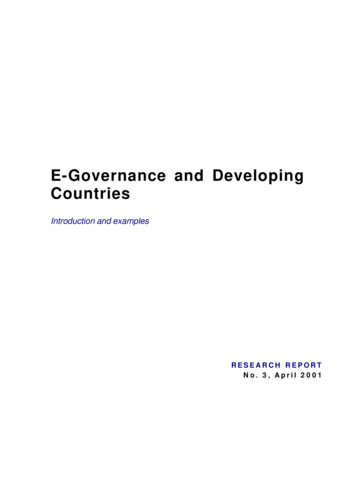
Transcription
E-Governance and DevelopingCountriesIntroduction and examplesRESEARCH REPORTNo. 3, April 2001
E-Governance and DevelopingCountriesIntroduction and examplesMichiel Backus
ContentBackgroundWhat is e-governanceDefining e-governanceObjectives23E-Governance modelE-Governance ModelOverview e-governance Solutions47Impact of TechnologyE-Governance in DevelopmentCase 1: Ghana - National Clearinghouse GhanaCase 2: Tanzania – ICT for Improved District GovernanceCase 3: Kenya – Busting Corruption Using the InternetOther e-governance Initiatives10111314Challenges for DevelopmentSWOT-Analyses e-governanceSuccess Factors1719Implementation of e-governanceApproachVision: e-governance PolicyStrategy: Framework for ActionProjects: ActionIICD ICT Roundtable Workshops2021222223E-Governance directoryE-Governance LinksOrganisationsE-Governance BibliographyE-Governance Web Resources24242542
BACKGROUNDE-governance is more than just a government website on the Internet. But what is it exactly?What are the benefits of e-governance? What can governments do to make it work?Solutions to development issues often requirechanges to government processes, e.g. bydecentralisation. Objectives are generally to improve efficiency and effectiveness and to savecosts. The driving force can also be public demand for online services and information thatincrease democratic participation, accountability, transparency, and the quality and speed ofservices. The implementation and use of ICT solutions can support governance reforms.E-governance will become more and more present around the world in the next few years.Internationally most countries are in the early stages of e-governance. A good start has beenmade in Europe, USA and in other Westernised countries such as Australia and Singapore.Over the coming years also developing countries and their citizens can also benefit from egovernance.This report explains what is meant by e-governance. It starts with a definition of e-governance,then presents a general e-governance model and several case studies and examples.Technology aspects are discussed, followed by a SWOT analysis on e-governance indeveloping countries. Finally, a description is given of what steps have to be taken to set up apolicy on e-governance and how implementation projects can be selected.E-Governance and Developing Countries1
WHAT IS E-GOVERNANCE?Imagine a situation in which all interaction with the government can be done through onecounter 24 hours a day, 7 days a week, without waiting in lines at government offices.In the near future this is possible if governments are willing to decentralise responsibilities andprocesses and they start to use electronic means such as the Internet. Each citizen can thenmake contact with the government through a website where all forms, legislation, news andother information will be available 24/7.Of course, at first the front office will retain several communication channels, such as physicalcounters, telephone, (e-)mail and Internet to serve everyone properly, but this will changedramatically in the next few years.In Europe and the USA, commercial banks already work according to this concept. Only in afew very special situations one has to go to a physical counter. Most transactions can be doneat either an ATM, by mail or by the Internet, which has saved banks an enormous amount ofcosts. In other words, they do more work, with less people, in less time and with less andsmaller offices: They use the Internet.Government, as a collector and source of information, may also follow this trend, in order toserve its customers (citizens, businesses, and other interest groups) better and to save costs bymaking internal operations more efficient.Defining E-governanceMany definitions exist for e-governance. Before presenting an overall definition of egovernance, the relation between governance, e-democracy and e-government is explained.E-democracy refers to the processes and structures that encompass all forms of electronicinteraction between the Government (elected) and the citizen (electorate).E-government is a form of e-business in governance and refers to the processes and structuresneeded to deliver electronic services to the public (citizens and businesses), collaborate withbusiness partners and to conduct electronic transactions within an organisational entity.E-Governance:In this report e-governance is defined as the application of electronic means in (1) theinteraction between government and citizens and government and businesses, as well as(2) in internal government operations to simplify and improve democratic, government andbusiness aspects of Governance.E-Governance and Developing Countries2
The term interaction stands for the delivery of government products and services, exchange ofinformation, communication, transactions and system integration.Government consists of levels and branches. Government levels include central, national,regional, provincial, departmental and local government institutions. Examples of governmentbranches are Administration, Civil Service, Parliament and Judiciary functions.Government operations are all back-office processes and inter-governmental interactions withinthe total government body.Examples of electronic means are Internet and other ICT applications.ObjectivesThe strategic objective of e-governance is to support and simplify governance for all parties government, citizens and businesses. The use of ICTs can connect all three parties and supportprocesses and activities. In other words, in e-governance uses electronic means to support andstimulate good governance. Therefore the objectives of e-governance are similar to theobjectives of good governance. Good governance can be seen as an exercise of economic,political, and administrative authority to better manage affairs of a country at all levels, nationaland local.It is useful here to present objectives for e-democracy and e-government. The two mainobjectives of e-democracy are1. To provide citizens access to information and knowledge about the political process, aboutservices and about choices available2. To make possible the transition from passive information access to active citizenparticipation by: Informing the citizen Representing the citizen Encouraging the citizen to vote Consulting the citizen Involving the citizenRegarding e-government, the distinction is made between the objectives for internally focusedprocesses (operations) and objectives for externally focused services.External strategic objectives. The external objective of e-government is to satisfactorilyfulfil the public’s needs and expectations on the front-office side, by simplifying theirinteraction with various online services. The use of ICTs in government operationsfacilitates speedy, transparent, accountable, efficient and effective interaction with thepublic, citizens, business and other agencies.Internal strategic objectives. In the back-office, the objective of e-government ingovernment operations is to facilitate a speedy, transparent, accountable, efficient andeffective process for performing government administration activities. Significant costsavings (per transaction) in government operations can be the result.It can be concluded that e-governance is more than just a Government website on the Internet.Political, social, economic and technological aspects determine e-governance.E-Governance and Developing Countries3
E-GOVERNANCE MODELThe three main target groups that can be distinguished in e-governance concepts aregovernment, citizens and businesses/interest groups. The external strategic objectives focus oncitizens and businesses and interest groups, the internal objectives focus on government itself.Abbreviations such as B2B (business to business) and B2C (business to consumer) are used,like in e-commerce, to shortly describe which of the main groups are interacting. The mostcommon group interactions in e-governance are presented schematically in Figure 3. The threeabbreviations in the figure, G2C, G2B and G2G are explained in Figure 2.e-democracyExternalXG2C: Government to CitizenG2B: Government to BusinessInternalG2G:GovernmenttoGovernmentFigure 2: Main group interactions in e-governancee-governmentXXXG2GCentral GovernmentCitizenG2CG2GG2BBusinessNGOsCivil SocietyLocal GovernmentG2GFigure 3: Interactions between main groups in e-governanceAs mentioned before, e-governance is more than a government website on the Internet. Whatare the opportunities and possibilities of e-governance in the future, and what services aredelivered at this moment?Gartner, an international e-business research consultancy firm, has formulated a four-phase egovernance model. This e-governance model can serve as a reference for governments toposition where a project fits in the overall evolution of an e-governance strategy.In most cases, governments start with the delivery of online information, but soon publicdemand and internal efficiency ask for more complex services. Of course this change will takeeffect gradually, some services will be online earlier than other services. In some cases thepublic demand is the driving force, in other cases cost saving aspects for the government areleading.According to Gartner, e-governance will mature according the four-phase e-governancematurity model. These phases have been defined based on experiences with e-commerce ande-governance in Europe and other Western regions.E-Governance and Developing Countries4
E-GovernanceEarly 90’sMid 90’sPresentFutureMaturity Model (Gartner)Informationà PresenceInteractionà Intake processTransactionà Complete transactionTransformationà Integration and organisational changesIn each of the four phases, the delivery of online services and use of ICTs in governmentoperations serve one or more of the aspects of e-governance: democracy, government,business.Increasing value toCitizen / BusinessPhase TransformationPhase ŽTransactionPhase ŒInformationPhase InteractionIncreasing complexityFigure 4: E-Governance Maturity Model (Gartner, 2000)The model does not mean that all institutions have to go through all phases and all at the sametime. On the contrary, in the Western world government institutions are in phase 1, 2 or 3. Thedifferences can be huge: the tax department can be in phase 3, while the department of publicworks is just in an early stage of phase one. It all depends on where the advantages arehighest.Another remark must be made. This model shows four phases for different e-governance (edemocracy and e-government) solutions. The assumption is made that the government hasalready defined an overall vision and e-policy. In the chapter “Implementation of e-governance”,this remark will be further explained.Phase Œ: InformationIn the first phase e-governance means being present on the web, providing the external public(G2C and G2B) with relevant information. The format of the first government websites is similarto that of a brochure or leaflet. The value to the public is that government information is publiclyaccessible; processes are described and thus become more transparent, which improvesdemocracy and service.Internally (G2G) the government can also disseminate information with static electronic means,such as the Internet. This phase it is all about information. From a 1-page presence website to asite with all relevant government information available to the public, in order to improvetransparency in democracy.E-Governance and Developing Countries5
Examples of information that Government wishes to disseminate may make availablepress noticesconsultation paperspolicieswhite papersnewshealth and safety advicebenefits and entitlementsapplicable regulationsgeographical datademographic dataeconomic datainformation collectedinform ation generated routinelyvalue added servicesbusiness yellow pages is required to supplyperformance indicatorsenvironmental indicatorsaudited accountspersonal datainternal policy documentscorrespondencemanagement reportsFigure 5: Examples of government informationPhase : InteractionIn the second phase the interaction between government and the public (G2C and G2B) isstimulated with various applications. People can ask questions via e-mail, use search enginesfor information and are able to download all sorts of forms and documents. These functionalitiessave time. In fact the complete intake of (simple) applications can be done online 24/7. Normallythis would have only been possible at a counter during opening hours.Internally (G2G) government organisations use Local Area Networks (LAN), intranets and e-mailto communicate and exchange data.The bottom line is that more efficiency and effectiveness is achieved because a large part of theintake process is done online. However, you still have to go to the office to finalise thetransaction, by paying a fee, handing over evidence or signing papers. The use of electroniccommunications tools speed up the internal government processes.Phase Ž: TransactionWith phase three the complexity of the technology is increasing, but customer (G2C and G2B)value will also be higher. Complete transactions can be done without going to an office.Examples of online services are filing income tax, filing property tax, extending/renewallicenses, visa and passports and online voting. Phase three is mainly complex becausesecurity and personalization issues – e.g., digital (electronic) signatures are necessaryenable legal transfer of services. On the business side the government is starting withprocurement applications.ofoftoe-In this phase, internal (G2G) processes have to be redesigned to provide good service.Government needs to create new laws and legislation that will enable paperless transactionswith legal certification. The bottom line is that now the complete process is online, includingpayments, digital signatures etc. This saves time, paper and money.Phase : TransformationThe fourth phase is the transformation phase in which all information systems are integratedand the public can get G2C and G2B servi ces at one (virtual) counter. One single point ofcontact for all services is the ultimate goal.E-Governance and Developing Countries6
The complex aspect in reaching this goal is mainly on the internal side, e.g. the necessity todrastically change culture, processes and responsibilities within the government institution(G2G). Government employees in different departments have to work together in a smooth andseamless way. In this phase cost savings, efficiency and customer satisfaction are reachinghighest possible levels.Overview e-governance solutionsExternal: G2CExternal: G2BInternal: G2GPhaseInformationŒ:Local / Departmental /National information (missionstatements andorganisational structureAddresses, opening hours,employees, telephonenumbersLaws, rules and regulationsPetitionsGovernment glossaryNewsBusiness informationAddresses, openinghours, employees,telephone numbersLaws, rules andregulationsKnowledge base (staticintranet)Knowledgemanagement (LAN)PhaseInteraction Downloading forms onwebsitesSubmitting formsOnline help with filling informs (permits, birth / deathcertificates)Intake processes for permitsetc.E-mailNewslettersDiscussion groups (edemocracy)Polls and questionnairesPersonalised web pagesNotificationDownloading forms onwebsitesSubmitting formsOnline help with fillingin forms (permits)Intake processes forpermits etc.E-mailNotificationE-mailInteractive knowledgedatabasesComplaint handlingtoolsPhaseTransactionŽLicense applications /renewalsRenewing car tags, vehicleregistrationPersonal accounts (mytax,myfines, mylicenses etc.)Payment of (property) taxesPayment of tickets and finesPaying utility billsRegistering and voting onlineLicense applicationsand renewals viawebsitePayment of onalised website withintegrated personal accountfor all servicesPersonalised websitewith integratedbusiness account for allservicesDatabase integrationPhase :TransformationFigure 6: Overview e-governance solutions for each phaseE-Governance and Developing Countries7
IMPACT OF TECHNOLOGYThe use of ICT means in Governance has impact on the following aspects:24/7 Service ModelSystems and processes have to be adapted to a completely new service model. Intakeprocesses are made self-service and even in the middle of the night a citizen should get animmediate (automated) response about the status of the application. Citizen’s expectationstowards government’s response times will change because of the new communication medium.E-mail should be seen a new but serious channel besides the traditional channels such astelephone, physical counter, post and fax.Need for ContentWebsites consist of content (information). Governments will have to collect (buy), produce andupdate content daily. In phase 1 content will be static, but in phase 2 content will be changingevery day. Content managers in each (large) department are responsible for the information onthe website.Human ResourcesEffective use of ICTs in an organisation requires training of people. People should feelcomfortable with the tools they can use otherwise they will return to their old working patternsand habits. Maintaining technological infrastructure requires IT skilled resources. Governmentswill have to compete with the private (commercial) sector to recruit the necessary IT skilledpeople.SecurityJust about any computer system is vulnerable to external attacks. As the government moves itscore processes (information, communication and transactions) to the Internet it is becoming farmore vulnerable. Internet increases the number of entry points exponentially. Protection ispossible with anti-virus software, firewall at gateways, encryption technology, and authenticidentification tools.PrivacyIn phases 3 and 4 governments possess detailed information about citizens and businesses,which is often held in multiple offices on many different computer systems (or still in paper files).The integration of data can result in situations where the privacy of individual citizens is indanger. It is the responsibility of the government to restrict the utilisation of private information,and secure such information from access by unintended parties. Due to public concernregarding privacy several countries have already passed data protection laws.E-Governance and Developing Countries8
IT DepartmentWith the implementation of e-governance IT is becoming more and more important ingovernment operations. The need for a professional IT department will inevitable increase, notonly during implementation, but also for maintenance of software, hardware and infrastructure.E-Governance and Developing Countries9
E-GOVERNANCE IN DEVELOPMENTCase 1: Ghana - National Clearinghouse GhanaAccess to accurate and timelyType Ž / e-Government / G2Ginformation is a critical pre-requisitefor national development. PolicyProject ownerMinistry of Communicationsmakers,planners,researchers,BudgetUS 244.000investors, etc. depend on reliablePeriod6 yearsinformation for planning and decisionmaking. The mission of the Ministry ofAdvisorIICDCommunications (MOC) is to developContact person Stijn van der Krogtpolicies that will help integratecommunication technologies and public information systems and also harness the full potentialof resources within the sector for effective communications.ProblemCurrently, in Ghana, there are a number of institutions and companies developing electronicinformation systems, catering to varied information needs of different categories of users. Thereis, however, very limited exchange of information among the institutions and between theinformation providers and the potential consumers. Consequently, the awareness of theexistence of electronic information is very limited. There are no cross-linkages between theinformation systems either, since most of them are not available in electronic form.Lacking access and co-ordination of the nation’s information flows is presenting an importantbottleneck to good governance in terms of an effective and transparent policy formulation andimplementation. Furthermore, it hampers access to information required by the government,private business, NGOs and the general public. Therefore the need exists to co-ordinate,integrate and improve access to these valuable sources of information.Development objectivesThe project is to contribute to national development in a number of ways. The primarydevelopment objectives are: To provide better co-ordination of the information facilities developed in government andprivate institutions. To improve and increase the exchange of information between the institutions. To provide better means of access to the information.Secondary objectives are: Sensitisation of institutions on collating and continually updating information on theiractivities. The development of information and communication skill of workers and users.Project objectivesTo improve the information facilities and access to public institutions, the project aims atdeveloping a test project for a national information clearing house at the Ministry ofCommunications. The clearinghouse will act as a broker of information between informationproviders and users in the public and private sector.E-Governance and Developing Countries10
Within the scope of the project, a clearinghouse facility will be set up at the Ministry ofCommunications and 4 government institutions will be linked up to the clearinghouse. Theinstitutions are: Ghana Export Promotion Council (GEPC) Ghana Free Trade Zones Board (GFTZB). Ghana Investment Promotion Centre (GIPC) Ministry of Roads and Transport (MRT)These institutions are selected because they both have already well-developed advancedinformation facilities. The target groups of the services developed by the project includegovernment institutions, NGOs and the private sector.The project objectives are two fold: Finding best practice for the development of a national information-clearing house,linking up public and private institutions. Finding best practice for the public access to electronic information services at theselected institutions.Case 2: Tanzania – ICT for Improved District GovernanceIn a follow-up to the recommendation of a National ICT roundtable, a feasibility study wasinitiated in August 1998. The feasibility study was conducted to investigate and recommendpossible areas in the government, at level of the district that could immediately be computerisedon a sustainable basis.The objectives of this study were: To identify areas in the governmentsector, that are amenable forimmediate computerisation,Phase Ž / e-Government / G2GProject ownerTanzania Commission forScience and TechnologyBudgetPeriodUS 38.0001999-2002AdvisorContact personIICDNic Moens Identify data flow patterns and theirreporting mechanisms within andacross sectors, and Conduct an inventory to establish the ICT’s strength at Kinondoni district headquarters.ProblemThe study revealed that most of the functions that are carried out by the district commissioner'soffice involve manual processes and are in greater extent ineffective and inefficient. As a resultthe following weaknesses emerged: Limited transparency: Limited free flow of information which leads to processes, sections/institutions and information not to be directly accessible to those concerned with them,and less information is provided to understand and monitor them. Handicapped strategic vision: Impaired broad and long-term perspective on the goodsociety, good governance and human development, as well as sense of what is neededfor such development. Limited resource utilisation: Due to absence of computerised Management InformationSystem resources are not managed or used properly with a view to optimise the wellbeing of people in a long term perspective.E-Governance and Developing Countries11
Development objectivesThe overall aim of this project is to bring about good governance in Kinondoni District, byharnessing information for decision-making through the use of Information and CommunicationTechnologies. The project further aims at establishing a pilot Management Information Systemfor good governance at the Kinondoni District Commissioners office.Specific objectives: Establishing a simple Management Information System at district level that will captureinformation generated from three selected areas namely: education, health and birth,marriage and death registration for decision making. Improve efficiency and effectiveness in capturing and processing information obtainedfrom the selected areas. Facilitate utilisation of the information system outputs for good governance. Examine sustainability of the entire process in view of the fees charged on servicerendered to beneficiaries. Provide training for district staff in computerised information collection, processing, anddissemination. Provide a computerised district governance model to be adopted by the district for allsectors and later on by other districts and central government departments.Sensitise the government machinery on the application of ICTs for good governance,thereby increase ICT application in good for more informed.Project objectives Databases on health, education, birth/death and marriage will be created at district levelto facilitate good governance. Timely and customised computer generated reports on education, health andregistration of birth/death and marriage for decision making to be derived fromestablished databases. Computerised District Management Information System and infrastructure for goodgovernance comprising of an electronic network and subsequent linkage to upper levelsof government and international networks. A skilled human resource base with ICT competencies in collection, processing,management and dissemination of sector information. Enhanced awareness within government and among the general public on the use ofinformation for decision-making and the application of ICTs to good governance. A manual describing a model District Management Information System to be used inother sections of Kinondoni district as well as other district councils in the country. A pilot project report on the application of ICT in the selected areas. The report will bethe basis for other advanced phases of the project.E-Governance and Developing Countries12
Case 3: Kenya – Busting Corruption Using the InternetIn many countries, one of the biggestimpediments to delivery of governmentservices is entrenched graft. Corruptionreduces the efficiency of service delivery,slows down the economy and discouragesforeign investments. In Kenya, the Kenya AntiCorruption Authority (KACA) has beenestablished to fight corruption.Phase / e-Government / G2CProject ownerKenya Anti-CorruptionAuthorityBudgetPeriodUS 1999-2002ProblemKACA has to date done a commendable job; however, they have mainly been dealing withhistorical, large-scale corruption cases. This has not been by choice, but because KACA hasnot been getting all the information it needs. Especially on the everyday petty corrupt practicescountrywide, due to limited channels of access by the public. KACA is currently usingtelephone, paper mail and one electronic mail - in reality, the major channel available to thepublic is the telephone. Many citizens have shied away from volunteering information to KACAbecause of lack of privacy.Project descriptionThe Information Technology Standards Association (ITSA) of Kenya has launched an ElectronicGraft Management pilot project, which aims to increase public awareness and encourage publicparticipation in fighting corrupt practices. The pilot project intends to use the Internet and e-mailas the channel for communication by the public for reporting. The idea is to introduce the use ofan Internet hotline, popularly know as online reporting mechanism. For the pilot project theexisting Internet infrastructure that currently covers six major towns will be used. At no cost thepublic will use the existing Internet Cafés and e-Touch centres in these towns for reporting. Inaddition to this, two remote locations, which do not have the required infrastructure, will also beset up to test the feasibility of connecting the larger rural areas.ITSA's pilot Electronic Graft Management project will offer a corruption reporting facility in sixtowns, two remote locations and the media will form the source points of information which willbe routed to the Electronic Graft Management (EGM) Centre. The EGM Centre will filter thisinformation electronically and forward/channel it to the relevant authorities for action.Partnerships are currently being formulated between ITSA and the relevant authorities.ChallengeThe greatest challenge facing the implementation of this project is "How the public will be madeto report genuine corruption voluntarily". ITSA proposes to use highly motivated youthvolunteers to inform the public in the selected areas about the availability of the online channel.The youth's campaign will be backed up by the news media. The awareness campaign willtarget groups such as teachers and traders associations, NGOs, community-basedorganisations, churches and religious organisations, as well as private and public institutions.There will also be door-to-door campaign (offices, shops, etc.). To be included in the awarenesscampaign will be the experiences of the public, ease of access to the available cafés and abilityto use them.The EGM Centre will monitor the volume of corruption reporting on a monthly basis. An increasein the volume over time will indicate that the number of people using this channel is increasing,which in turn implies increased public awareness, and trust in this channel. The EGM Centre willalso solicit statistical feedback from the implementing bodies on the actions taken, and make itavailable to the public, to motivate them to continue using the channel.E-Governance an
Figure 4: E-Governance Maturity Model (Gartner, 2000) The model does not mean that all institutions have to go through all phases and all at the same time. On the contrary, in the Western world government institutions are in phase 1, 2 or 3. The differences can be huge: the tax department can be in phase 3, while the department of public
